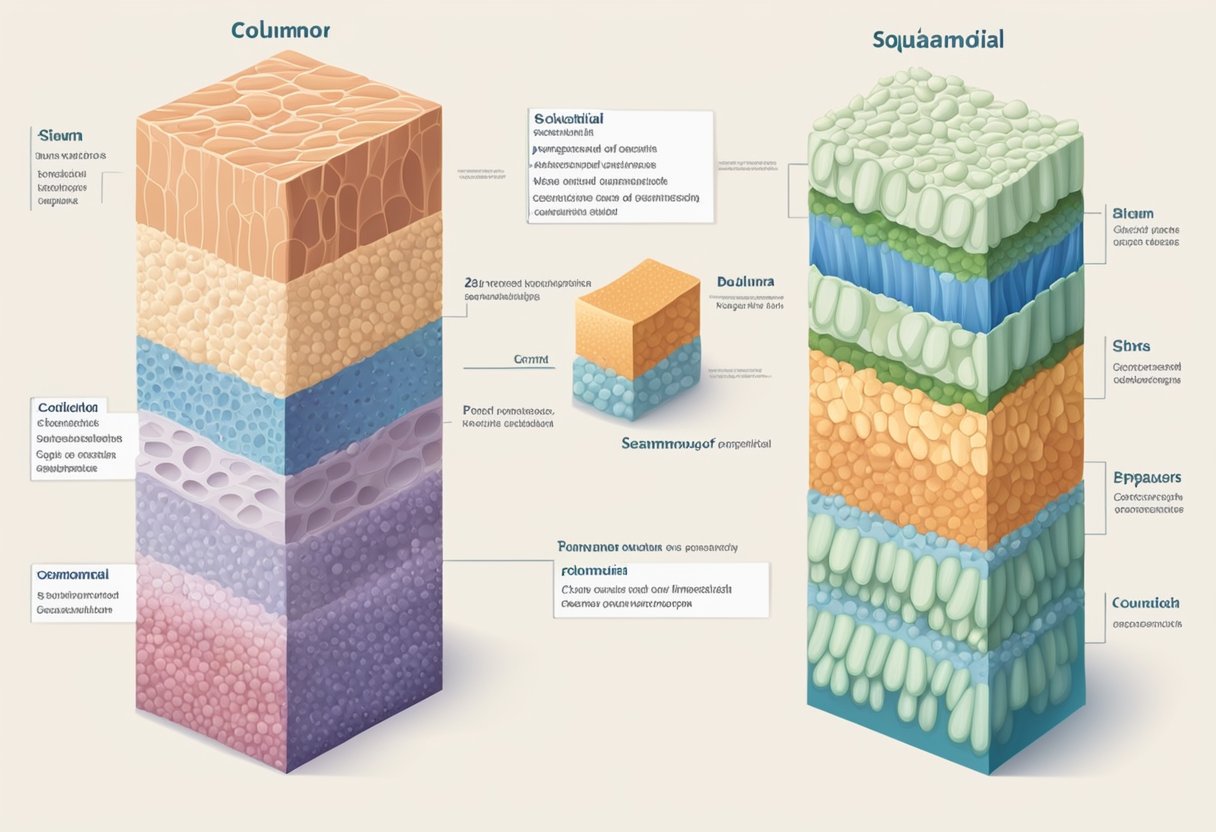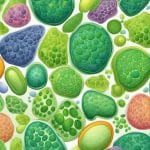Types Of Epithelial Tissue
Epithelial tissue is one of the four basic types of tissue in the human body, along with connective tissue, muscle tissue, and nervous tissue. It covers the surfaces of the body and lines the internal organs and cavities. Epithelial tissue is made up of cells that are tightly packed together, forming a continuous layer that functions as a barrier to protect the body from external factors such as bacteria, viruses, and other harmful substances.

Classification of Epithelial Tissue is based on the shape and arrangement of cells. There are four basic types of epithelial tissue: simple squamous, simple cuboidal, simple columnar, and stratified squamous. Simple squamous epithelium is a single layer of flat cells that line the blood vessels, lungs, and body cavities. Simple cuboidal epithelium is a single layer of cube-shaped cells that line the ducts of glands and the kidney tubules. Simple columnar epithelium is a single layer of tall, slender cells that line the digestive tract and the uterus. Stratified squamous epithelium is a multilayered tissue that forms the outer layer of the skin and lines the mouth, throat, and esophagus.
Functional Roles of Epithelial Tissue are diverse and include secretion, absorption, protection, and sensation. Epithelial cells secrete mucus, enzymes, and hormones. They also absorb nutrients and water from the digestive tract and filter waste products from the blood in the kidneys. Epithelial tissue provides a protective barrier against physical, chemical, and biological agents, and it contains sensory receptors that detect changes in the environment, such as temperature, pressure, and pain.
Key Takeaways
- Epithelial tissue is one of the four basic types of tissue in the human body.
- There are four basic types of epithelial tissue: simple squamous, simple cuboidal, simple columnar, and stratified squamous.
- The functional roles of epithelial tissue are diverse and include secretion, absorption, protection, and sensation.
Classification of Epithelial Tissue
Epithelial tissue is classified based on two criteria: cell shape and cell layer. The three principal shapes of epithelial cells are squamous, cuboidal, and columnar. Squamous epithelial cells are flat and scale-like in appearance, cuboidal epithelial cells are cube-shaped, and columnar epithelial cells are tall and cylindrical. The number of cell layers present in the tissue determines whether it is simple or stratified.
Simple Epithelium
Simple epithelium consists of a single layer of cells. It is further classified based on the shape of the cells. Simple squamous epithelium is composed of flattened cells that allow for diffusion and filtration. Simple cuboidal epithelium is composed of cube-shaped cells that are involved in secretion and absorption. Simple columnar epithelium is composed of tall, cylindrical cells that are involved in absorption and secretion. Pseudostratified epithelium appears to be stratified, but all the cells rest on the basement membrane and only the tallest cells reach the surface.
Stratified Epithelium
Stratified epithelium consists of two or more layers of cells. It is also classified based on the shape of the cells. Stratified squamous epithelium is composed of flattened cells in the outermost layer and cuboidal or columnar cells in deeper layers. It is found in areas that experience wear and tear, such as the skin and the lining of the mouth. Stratified cuboidal epithelium is rare and found in sweat and mammary glands. Stratified columnar epithelium is also rare and found in the pharynx, male urethra, and some glandular ducts.
Specialized Epithelial Structures
Transitional epithelium is a specialized type of stratified epithelium that is found in the urinary system. It is capable of stretching and recoiling, allowing the urinary organs to expand and contract. Glandular epithelium is composed of cells that secrete substances, such as hormones or enzymes. It can be either exocrine or endocrine. Exocrine glands secrete their products into ducts that lead to the surface of the body or to a cavity. Endocrine glands secrete their products directly into the bloodstream.
In summary, epithelial tissue can be classified based on cell shape and cell layer. Simple epithelium consists of a single layer of cells, while stratified epithelium consists of two or more layers. Epithelial tissue can also be specialized, such as transitional epithelium and glandular epithelium. Understanding the different types of epithelial tissue is important for understanding their functions in the body.
Functional Roles of Epithelial Tissue
Epithelial tissue is a type of tissue that covers and lines the surfaces of organs, cavities, and structures in the body. It has a variety of functions, which include protection, secretion, absorption, filtration, and excretion.
Protection and Barrier
One of the main functions of epithelial tissue is to provide a protective barrier against physical, chemical, and biological agents. The skin is an example of epithelial tissue that protects the body from the external environment. Epithelial tissue also protects internal organs and structures, such as the lining of the digestive tract and the respiratory system.
Keratin is a protein that is present in some types of epithelial tissue, such as the skin, and provides additional protection. It makes the tissue tough and resistant to abrasion and damage.
Secretion and Absorption
Epithelial tissue is involved in the secretion and absorption of substances in the body. Glands are specialized structures that are made up of epithelial tissue and produce and secrete substances such as hormones, enzymes, and mucus.
In the digestive system, the lining of the small intestine is made up of epithelial tissue that is specialized for absorption. It has a large surface area and is covered with microvilli, which increase the area available for absorption.
Filtration and Excretion
Epithelial tissue is also involved in filtration and excretion. In the kidneys, for example, the epithelial tissue of the nephrons filters waste products and excess water from the blood, which are then excreted in urine.
Overall, epithelial tissue plays a crucial role in maintaining the structure and function of organs and structures in the body. Its functions are diverse and specialized, depending on the location and type of tissue.
Anatomical Features of Epithelial Cells
Epithelial tissue is one of the four primary types of tissues in the human body. It is composed of closely packed cells that form a protective barrier on the surface of organs, cavities, and glands. The cells in epithelial tissue have several anatomical features that enable them to perform their functions effectively.
Cell Polarity
Epithelial cells exhibit polarity, meaning they have distinct apical and basal surfaces. The apical surface faces the external environment or a lumen, while the basal surface is anchored to the underlying connective tissue. This polarity allows the cells to perform specialized functions such as absorption, secretion, or transport.
Cell Junctions and Membranes
Epithelial cells are held together by specialized cell junctions that provide strength and stability to the tissue. The three main types of junctions are tight junctions, anchoring junctions, and gap junctions. Tight junctions form a barrier that prevents substances from passing between cells. Anchoring junctions, such as desmosomes, provide mechanical strength to the tissue. Gap junctions allow for communication and exchange of small molecules between cells.
The cell membrane of epithelial cells is also specialized. The apical surface may have microvilli or cilia that increase surface area and aid in absorption or movement. The basal surface may have invaginations called basal infoldings that increase the surface area for attachment to the underlying connective tissue.
Epithelial cells also contain various organelles such as mitochondria, endoplasmic reticulum, and Golgi apparatus that perform specialized functions such as energy production and protein synthesis.
In summary, the anatomical features of epithelial cells such as polarity, cell junctions, and specialized membranes enable them to perform specialized functions effectively.
Epithelial Tissue in Organ Systems
Epithelial tissue is one of the four main types of tissue in the human body. It lines the internal and external surfaces of the body, including the organs, blood vessels, and body cavities. This tissue has a variety of functions, including protection, secretion, and absorption.
Respiratory System
The respiratory system is made up of organs and tissues that help us breathe. The respiratory tract is lined with epithelial tissue that helps to protect the lungs from harmful particles and microorganisms. The alveoli, which are small air sacs in the lungs, are also lined with epithelial tissue. This tissue helps to exchange oxygen and carbon dioxide between the air and the blood.
Digestive System
The digestive system is responsible for breaking down food and absorbing nutrients. The mouth, esophagus, and digestive tract are all lined with epithelial tissue. This tissue helps to protect the digestive organs from damage and aids in the absorption of nutrients.
Urinary System
The urinary system is responsible for removing waste products from the body. The ureters, urinary bladder, and urethra are all lined with epithelial tissue. This tissue helps to protect the urinary organs from damage and aids in the removal of waste products from the body.
In summary, epithelial tissue plays an important role in the function of many organ systems in the human body. It helps to protect organs from damage, aids in absorption and secretion, and plays a critical role in the exchange of gases and nutrients.






